Mark Attributes
The Attributes are explained for each Mark type.
•“Density Bar Details”
Circle Mark Details
Mark Sets Categories: Pages, Fold Sheet, Press Sheet, Image, Sheet
The Circle Mark draws a rectangle with a border and fill color. This mark is always printed using knock-out.
Width
Specifies the horizontal size of the mark. You can create oval shapes by unlocking the link and entering different values for Width and Height.
Height
Specifies the vertical size of the mark.
Border pen
Choose a pen to draw the lines; lines have different thicknesses.
NOTE: The border is created on the inside of the bounding box.
Fill with color
This option is selected by default.
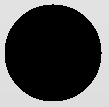 |
Click the variable button, and select one or more options to determine on which plate(s) the mark will be printed:
 |
See “About Colors and Depth for Printing Marks” for more information on using colors to print marks.
Color Bar Mark Details
Mark Sets Categories: Press Sheet, Image, Product Marks
The Color Bar generates a bar of color patches using the colors that are present on the press sheet (offset and wide-format) or in the product.
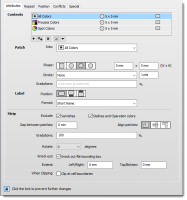 |
Contents
Each row shows the type of the element, the shape and stroke of the patch, the size, the local gradations and the presence and position of the label. You can add, duplicate, delete and change the order of elements in the list.
Patch
•Inks: Select the inks (colors) to add to the color bar. The drop-down lists the Inks’ options.
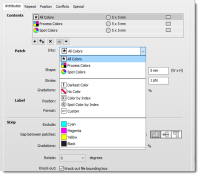 |
.
Ink | Description |
|---|---|
All colors | Generates patches for all colors in scope. |
Process colors | Generates patches for all process colors in scope. |
Spot colors | Generates patches for all spot colors in scope. |
Darkest color | Generates a patch for the darkest color. |
No color | Generate a patch that prints no color. |
Color by index | Generates a patch that prints the specified ith color, with i being integer numbers starting from 1. |
Spot color by index | Generates a patch for the specified color specification, using the extended color specification syntax. |
Custom | Generates a patch for the specified process color. The menu shows a list of the colors in the currently selected ink set. In the Mark Engraver, the lists shows the four standard process colors (CMYK). |
Process color list | Generates a patch for the specified spot color. |
Spot color list | The menu shows a list of the actual spot colors that are in scope. The circular icons show the actual color. |
•Shape: Select the shape of the patch.
•Size: Specify the width and height of the patch. The shape always fills the specified size.
•Stroke: Specify how to stroke the patch.
•Registration: Prints the stroke in all colors in the current scope, same as "*".
•Darkest Color: Prints the stroke in the darkest color in the current scope, same as "!".
•None: Do not stroke the patch.
•Width: The width of the stroke. It is disabled when the stroke is set to None.
•Gradations: Specify the gradations as a comma-separated list of densities (0–100). An empty entry signifies that the patch follows the gradations of the bar. In that case, the field shows the text in gray text.
Label
•Position: Select whether to have no label or a label below or above the patch.
•Format: Select how to format the label.
•Short name: Print the short name of the color.
•Full name: Print the full name of the color.
•Short name, Gradation: Print the short name of the color and the gradation (without %).
•Single line: Select to print the gradation on the same line as the color name (separated by a space) or below the name (centered). It is disabled when not printing the gradation.
Strip
•Exclude: Select the special colors that will not be included when using any of the following patch entries; All colors, Process colors, Spot colors. These colors will not be listed in the color selection menus, either.
•Varnishes: Exclude all colors that are found in the Varnish category of the Special Colors.
•Dielines/Operation Colors: Excludes all colors that are found in the Dielines category of the Special Colors or that are recognized as Operations.
•Gap between patches: The gap between two successive patches.
NOTE: The bounding box of the color bar is at the edges of the outer patches; it does not include 1/2 gap size.
•Align patches: The vertical alignment of the patches when they have different heights. An empty value is interpreted and replaced by 100%.
•Gradations: Enter 1 or more comma-separated graduation values in range 1–100.
•Rotate: The rotation of the color bar.
•Knock-out: Select to knock out the area under the mark. The knock-area is the bounding box of the mark.
•Extend: Extends the knock-out area of the mark by the specified values for the left and right edges and for the top and bottom edges; can be used for conflict checking.
•When Clipping: Select to clip the mark (when it needs clipping) at the boundaries of each cell so that all patches are printed with the full size.
NOTE: The left and right edges of the bounding box of a color bar are always at the edges of a patch, i.e., it does not include the gap.
Crop Mark Details
Mark Sets Category: Pages, Image
 |
A Crop Mark is a horizontal and a vertical line to indicate where the page has to be cropped.
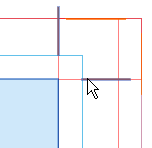 |
Type
A drop-down list with 2 options for what the crop mark indicates:
•Page Trim: the final size of the pages
•Page Bleed: perpendicular lines at the corner of the bleed zone of a page, indicating the bleed area
Distance from corner
Specifies the distance between the center of the mark and the page corner; the page corner can be for the Page Trim or the Page Bleed.
Line length
Specifies the length of the mark.
Pen
Choose a pen to draw the lines; lines have different thicknesses.
Hiding
Selected by default and hides the marks between adjacent pages.
Shingling
Specify whether shingling is to be applied or not.
NOTE: Crop marks only have the Layer settings to be defined in the Position tab.
Cross Mark Details
Mark Sets Category: Fold Sheet
A Cross mark indicates the crosspoint of two gutters, or at the endpoint of a gutter. They are commonly used in web production schemes to verify the correctness of cutting, slitting, and folding.
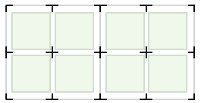 |
Length
Specifies the length of the line in a full cross, e.g. the line segments of a cap are half the specified length.
Pen
Choose a pen to draw the cross lines.
Hiding
Hides the marks on the outside of the fold sheet.
Cut Mark Details
Mark Sets Category: Fold Sheet, Sheet
 |
A Cut Mark is a horizontal and a vertical line in the corners of a Fold Sheet to indicate the boundaries of the Fold Sheet and where it is to be cut.
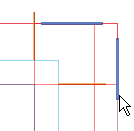 |
Distance from corner
Specifies the distance between the corner end of the mark and the Fold Sheet corner.
Line length
Specifies the length of the mark.
Pen
Choose a pen to draw the lines; lines have different thicknesses.
NOTE: There is no option to hide marks between adjacent Fold Sheets.
Cutter Registration Mark Details
Mark Sets Category: Sheet
 |
Cutter registration marks are reference dots which are drawn on a layout to enable cutting with X/Y cutting devices.
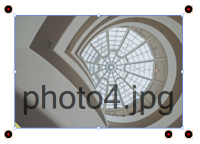 |
Type
The following types of Cutter Registration marks are available:
•Filled circle
•Reversed circle
•Filled rectangle
•Reversed rectangle
Diameter/Width, Height
The diameter/width and height of the circle/rectangle.
Outer size
The diameter of the reversed circle.
Distance from images
The distance of the dots from the edge of the image or image block.
Color/Reverse Color
The colors of the filled circle and reversed circle can be specified separately. Click the variable button, and select one or more colors to change the color:
 |
See “About Colors and Depth for Printing Marks” for more information on using colors to print marks.
Location
In the location panel, you specify where you want the dots to appear, and depending on the chosen location, the number of marks. The following options are available from the drop-down list:
Corners
Dots are placed at the corners of the image block. 3, 4 or 5 dots can be placed to indicate the lay of the cut block.
Individual Images
Dots are placed along a cut path that takes into account the nested arrangement of all the images. Here you can choose between Few and Many.
Top/Bottom
Dots are placed along the top and bottom of the image block, and you can set the number of dots by specifying the distance between them.
Left/Right
Dots are placed along the left and right side of the image block, and you can set the number of marks by specifying the distance between them.
All Sides
Dots are placed along all sides of the image block, and you can set the number of marks by specifying the distance between them.
Max. distance between marks
Set the distance between adjacent dots if you require more than the default number of dots.
Shift top/left marks
The offset applied to the dots on the top or left side.
Distance from
The distance of the dots from the edges of the images or media.
File Mark Details
Mark Sets Categories: Pages, Fold Sheet, Press Sheet, Image, Sheet, Product
 |
Use a File Mark, if you want to place a specific EPS or PDF file as a mark.
 |
File
Click the File list and select one of the available EPS or PDF files. The file is selected as the mark to be used and you see the size and number of colors used for the mark.
NOTE: You can open the Marks Resource by clicking the Open File Marks button, for example, to import a new mark.
•Scale: Specifies the scaling percentage of the file. The default is 100% in both directions. The link button keeps both directions at the same scale.
•Knock-out: Select to knock out the area under the mark. The knock-area is the bounding box of the mark.
•Extend: Extends the knock-out area of the mark; can be used for conflict checking.
When clipping
Only enabled if the selected file has an internal cell structure. Select if you only want the mark to be clipped at the cell boundaries of the mark (e.g. color bars); clear if it is alright to clip the mark anywhere.
Rotate
Specify the rotation angle for the mark (0, 90, 180, or 270 degrees).
NOTE: The selected file is copied into a reserved directory on the server.
Fotoba Mark Details
Mark Sets Category: Sheet
 |
Fotoba marks consist of horizontal and vertical lines which are drawn on a layout to enable cutting with a Fotoba cutting device.
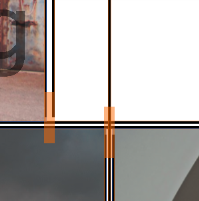 |
Horizontal/Vertical Cut Marks
Fotoba cut marks are drawn along the horizontal and vertical sides of the individual images on a layout. Horizontal lines are drawn by default and you can optionally specify vertical lines.
Type: Single mark, Double mark
Draws single or a double lines to indicate cutting.
Line thickness
The thickness of each line.
Inner white
The distance between the lines of a double mark.
Side Mark
The side mark is a vertical line which is drawn in addition to the vertical cut mark.
Distance from image
The distance from the image to the side mark.
Line thickness
The thickness of the side mark line.
Color
The color of all the cutting lines. Click the variable button, and select one or more colors to change the color of the cutting lines:
 |
See “About Colors and Depth for Printing Marks” for more information on using colors to print marks.
Grommet Mark Details
Mark Sets Category: Image, Sheet
 |
Grommet marks are sequential marks which are placed along the sides of an image or layout. These marks are printed on the layout and indicate where reinforced eyelets (grommets) can be produced. The marks are not part of the cut file.
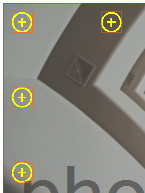 |
Mark
First you specify the appearance of the marks.
Grommet type
Three types of grommet marks are available:
•Circle
•Circle with cross
•Cross
Diameter
The diameter of the circle.
Line thickness
The thickness of all the lines.
Line length
The length of the 2 lines of the cross.
Color
The color of all the cutting lines. Click the variable button, and select one or more colors to change the color of the cutting lines:
 |
See “About Colors and Depth for Printing Marks” for more information on using colors to print marks.
Placement
In the placement panel, you specify where you want the grommet marks to appear.
Placement
You can choose to place the grommet marks along all sides of the image or layout, left and right, or top and bottom.
Distance from edge
The horizontal and vertical distances of the grommet from the edge of the image or sheet.
Max. distance between marks
The maximum horizontal and vertical distances between adjacent marks.
Line Mark Details
Mark Sets Categories: Pages, Fold Sheet, Press Sheet, Image, Sheet
 |
The Line Mark draws a line that can be used for various purposes in production.
Type
You can choose to draw a line at a specific location and with a specified size (custom), or let the line resize automatically to match a chosen target (auto-sizing).
Auto-sizing line settings:
Target
Choose the edge where you want to place the line (left, right, top, bottom) and the target box (page, fold sheet, spine, etc.). The available targets depend on the mark category. In the Offset field you can specify a distance from inside or outside the target box. The distance is from the center of the line to the target.
Length
An auto-sizing line is delimited by the target box you chose to position the line, (from target), or from other available boxes depending on the mark category.
Extend
Enter a negative or positive value to respectively shorten or extend the line in both directions.
Pen
Choose a pen to draw the lines; lines have different thicknesses.
Custom line settings:
Length
Specifies the length of the mark.
Pen
Choose a pen to draw the lines; lines have different thicknesses.
Angle
Specify the rotation angle for the mark (0, 90, 180, or 270 degrees).
Page Fold Line Mark Details
Mark Sets Category: Pages
 |
A Page Fold Line Mark draws a set of vertical or horizontal lines that indicate where to fold on a single page element.
Distance from page trim
Specifies the distance from the nearest end of the mark to the page trim.
By default, Apogee Impose only prints the fold marks on the outside of the page, but not on the inside. To draw them on the inside of the page, specify a negative value for Distance from page trim and allow the mark to overlap the page content.
Line length
Specifies the length of the mark.
Pen
Choose a pen to draw the lines; lines have different thicknesses.
Rectangle Mark Details
Mark Sets Categories: Pages, Fold Sheet, Press Sheet, Image, Sheet
 |
The Rectangle Mark draws a rectangle with a border and fill color. This mark is always printed using knock-out.
Around
Choose the reference for drawing the mark. Choose Custom to use all the options on the Position tab, or choose a target object (Image block, sheet, etc.) if you want to draw the mark around an object. The available objects depend on the mark category.
Expand
If you choose a target object for the Around option, you can also set a distance from the object where the mark will be drawn. Enter a positive value to draw a mark which is larger than the object (e.g. a rectangle around an image block), or a negative value for a mark which is smaller than the object.
Width
Specifies the horizontal size of the mark.
Height
Specifies the vertical size of the mark.
Border pen
Choose a pen to draw the lines; lines have different thicknesses.
NOTE: The border is created inside the mark.
Fill with color
This option is selected by default.
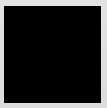 |
Click the variable button, and select one or more options to determine on which plate(s) the mark will be printed:
 |
See “About Colors and Depth for Printing Marks” for more information on using colors to print marks.
Registration Mark Details
Mark Sets Category: Press Sheet, Fold Sheet, Sheet
 |
A Registration Mark draws a series of marks which are used to check that the registration of the different printing colors is correct.
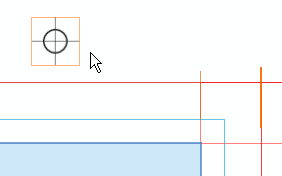 |
File
Click the File list and select one of the available EPS or PDF files. The file is selected as the mark to be used and you see the size and number of colors used for the mark.
The preview pane shows the selected mark.
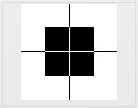 |
NOTE: You can open the Marks Resource by clicking the Open File Marks button, for example, to import a new mark.
Knock-out
Select to knock out the area under the mark. The knock-area is the bounding box of the mark.
Extend
Extends the knock-out area of the mark; can be used for conflict checking.
Rotate
Specify the rotation angle for the mark (0, 90, 180, or 270 degrees).
Where
Click in the diagram to specify where the mark is printed on the Press Sheet: in the four corners, the four center-side positions, or any other combination.
 |
Offset from edges
Distance between the center of the mark and the edges of the Press Sheet (including the lay).
Station Number Mark Details
See Text Mark Details, except for the Text field which is a number that is generated automatically to indicate the position of the product on a sheet.
Text Mark Details
Mark Sets Categories: Pages, Fold Sheet, Press Sheet, Image, Sheet, Product
 |
Text Marks are used to print text on a Press Sheet and identify Press Sheets by printing the job name, order number, color name, etc.
Text
In the Text field, you can specify which text is to be used as a mark. You have three options:
•Type some text in the Text field.
•Select a variable from the drop-down list. This list appears when you click in the Text field the button next to the field.
•A combination of the two previous methods, e.g. some text followed by a variable
Font
Select a font and a point size for the text mark.
Length
If you want you can change the calculated length of the text mark which is based on the amount of text, the point size and the variable. You can revert to the default, calculated length by clicking the revert arrow.
Script
Select a Roman, Chinese, Hebrew or Japanese script for the text mark. Choosing Chinese or Japanese activates the Writing Direction option.
NOTE: If you choose Chinese or Japanese, don’t forget to select a relevant font for these languages in the Font drop-down list.
Writing Direction
Horizontal is selected by default for Roman script (e.g. European languages) and can’t be changed; choosing Chinese or Japanese script activates the following options:
Horizontal
Select this option to place the text characters horizontally; the text is left-aligned in the text box.
 |
NOTE: The anchor point in the Mark Position tab is also used for aligning a Text mark. For example, placing a Text mark in the top right position means the text will grow from right to left and it is right-aligned in the text box.
Vertical
Select this option to place the characters underneath each other (certain Asian languages).
 |
Use Arabic Numerals
Select this option to use Arabic numerals in vertical text.
Color
Click the variable button, and select one or more options to determine which plate(s) will print the mark:
 |
See “About Colors and Depth for Printing Marks” for more information on using colors to print marks.
Readability
Select the options to improve the readability:
•Underline text: Underlines the text.
•Outline text: The text is outlined with a 1-point line at 0% of the specified text color, printed in knock-out around the type.
•Knock-out text box: Knocks out the area under the text. The knock-out area is the bounding box of the mark.
Extend
Extends the knock-out area of the mark; can be used for conflict checking.
Rotate
Specify the rotation angle for the mark (0, 90, 180, or 270 degrees).
doc. version 6.1.1